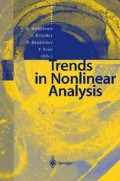Abstract
The design of pharmaceuticals, briefly called drug design, is a pyramidal multistage process, from a broad basis to an extremely narrow tip:
-
molecular recognition studies
-
intracellular impact studies
-
physiological investigations
-
animal experiments
-
clinical tests
-
market introduction
The basis level “molecular recognition studies”, in turn, consists of two parts: studies in the chemical lab and studies in the virtual lab by means of the computer, often named as computational drug design. The impact of this rather new scientific field cannot be overestimated: The cost of identifying a marketable drug out of a huge set of promising chemical substances is commonly estimated as 500 million Euro. If, at the basis level, the number of promising drug candidates could be halved, then the cost per successful marketable pharmaceutical would also roughly be halved, not to mention the reduction of “time to market”.
Access this chapter
Tax calculation will be finalised at checkout
Purchases are for personal use only
Preview
Unable to display preview. Download preview PDF.
References
A. Amadei, A.B.M. Linssen, H.J.C. Berendsen. Essential dynamics on proteins. Proteins 17, pp. 412–425 (1993).
V. I. Arnold. Mathematical Methods of Classical Mechanics. Second edition. Springer, Heidelberg, New York (1989).
M. Dellnitz, A. Hohmann. A subdivision algorithm for the computation of unstable manifolds and global attractors, Numer. Math. 75, pp. 293–317 (1997).
M. Dellnitz, O. Junge. On the approximation of complicated dynamical behavior, SIAM J. Num. Anal. 36, pp. 491–515 (1999).
P. Deuflhard and F. Bornemann. Numerische Mathematik II. Gewöhnliche Differentialgleichungen. 2. Auflage. Walter de Gruyter, Berlin, New York (2002).
P. Deuflhard, F. Bornemann. Scientific Computing with Ordinary Differential Equations. Springer, Berlin, Heidelberg, New York (2002).
P. Deuflhard, M. Dellnitz, O. Junge, Ch. Schütte. Computation of essential molecular dynamics by subdivision techniques. In [8], pp. 98–115 (1999).
P. Deuflhard, J. Hermans, B. Leimkuhler, A. E. Mark, S. Reich, R. D. Skeel, editors. Computational Molecular Dynamics: Challenges, Methods, Ideas, volume 4 of Lecture Notes in Computational Science and Engineering. Springer, Berlin, Heidelberg, New York (1999).
P. Deuflhard, A. Hohmann. Numerische Mathematik I. Eine algorithmisch orientierte Einführung. 3. Auflage. Walter de Gruyter, Berlin, New York (2002).
P. Deuflhard,A. Hohmann. Introduction to Scientific Computing. 2nd edition. Springer, Berlin, Heidelberg, New York (2002).
P. Deuflhard, W. Huisinga, A. Fischer, Ch. Schütte. Identification of almost invariant aggregates in reversible nearly uncoupled Markov chains. Lin. Alg. Appl. 315, pp. 39–59 (2000).
A. Fischer, F. Cordes, C. Schütte. Hybrid Monte Carlo with adaptive temperature in mixed-canonical ensemble: Efficient conformation analysis of RNA. J. Comput. Chem. 19, pp. 1689–1697 (1998).
A. Fischer, Ch. Schütte, P. Deuflhard, and F. Cordes. Hierarchical uncoupling-coupling of metastable conformations. In [24], (2002).
T. Gallìat. Adaptive Multilevel Cluster Analysis by Self-Organizing Box Maps. Submitted as PhD thesis, Department of Mathematics and Computer Ccience, Free University of Berlin, (March 2002).
T. Galliat, P. Deuflhard, R. Roitzsch, F. Cordes. Automatic identification of metastable conformations via self-organized neural networks. In [24], (2002).
T. Galliat, W. Huisinga, P. Deuflhard. Self-organizing maps combined with eigenmode analysis for automated cluster identification. In H. Bothe and R. Rojas, editors, Proceedings of the 2nd International ICSC Symposium on Neural Computation, Academic Press, pp. 227–232 (2000).
L. Greengard, V. Rokhlin On the evaluation of electrostatic interactions in molecular modeling. Chem. Ser. 29A, pp. 139–144 (1989).
T.A. Halgren. Merck molecular force field. I-V. J. Comp. Chem., 17, pp. 490641 (1996).
T. Kato. Perturbation Theory for Linear Operators. Springer, Berlin, Heidelberg, New York (1995).
T. Kohonen. Self-Organizing Maps. Springer, Berlin, Heidelberg, New York, 3rd edition (2001).
C. D. Meyer. Stochastic complementation, uncoupling Markov chains, and the theory of nearly reducible systems. SIAM Rev., 31, pp. 240–272 (1989).
J. Sanz-Serna, M. Calvo. Numerical Hamiltonian Problems. Chapman and Hall, London, UK (1994).
T. Schlick. Some Failures and Successes of Long-Time Approaches to Biomolecular Simulations. In [8], pp. 227–262 (1999).
T. Schlick, H. H. Gan, editors. Computational Methods for Macromolecules: Challenges and Applications - Proc. of the 3rd Intern. Workshop on Algorithms for Macromolecular Modelling, New York, 2000. Springer, Berlin, Heidelberg, New York, 2002, in press.
Ch. Schütte. Conformation Dynamics: Modelling, Theory, Algorithm, and Application to Biomolecules. Habilitation thesis, Department of Mathematics and Computer Science, Free University of Berlin, 1998. Available as ZIB-Report SC-99–18 via http://www.zib.de/bib/pub/pw/.
Ch. Schütte, A. Fischer, W. Huisinga, P. Deuflhard. A direct approach to conformation dynamics based on hybrid Monte Carlo. J. Comput. Phys., Special Issue on Computational Biophysics, 151, pp. 146–168 (1999).
Author information
Authors and Affiliations
Editor information
Editors and Affiliations
Additional information
Dedicated to Good Bill Hunting, Chief of Mount Highdle tribe, on the occasion of his 60th birthday
Rights and permissions
Copyright information
© 2003 Springer-Verlag Berlin Heidelberg
About this paper
Cite this paper
Deuflhard, P. (2003). From Molecular Dynamics to Conformation Dynamics in Drug Design. In: Kirkilionis, M., Krömker, S., Rannacher, R., Tomi, F. (eds) Trends in Nonlinear Analysis. Springer, Berlin, Heidelberg. https://doi.org/10.1007/978-3-662-05281-5_6
Download citation
DOI: https://doi.org/10.1007/978-3-662-05281-5_6
Publisher Name: Springer, Berlin, Heidelberg
Print ISBN: 978-3-642-07916-0
Online ISBN: 978-3-662-05281-5
eBook Packages: Springer Book Archive

